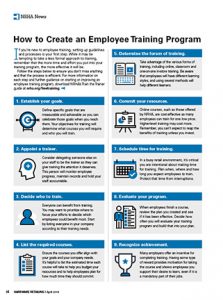
Click here to download a full pdf.
If you’re new to employee training, setting up guidelines and processes is your first step. While it may be tempting to take a less formal approach to training, remember that the more time and effort you put into your training program, the more effective it will be.
Follow the steps below to ensure you don’t miss anything and that the process is efficient. For more information on each step and further guidance on starting or improving an employee training program, download NRHA’s Train the Trainer guide.
1. Establish your goals.
Define specific goals that are measurable and achievable so you can celebrate those goals when you reach them. Your objectives for training will determine what courses you will require and who you will train.
2. Appoint a trainer.
Consider delegating someone else on your staff to be the trainer so they can give training the attention it deserves. This person will monitor employee progress, maintain records and hold your staff accountable.
3. Decide who to train.
Everyone can benefit from training. You may want to prioritize where to focus your efforts to decide which employees could benefit most. Start by listing everyone in your company according to their training needs.
4. List the required courses.
Ensure the courses you offer align with your goals and your company needs. It’s helpful to list the estimated time each course will take to help you budget your resources and to help employees plan for how much time they should commit.
5. Determine the forum of training.
Take advantage of the various forms of training, including online, classroom and one-on-one in-store training. Be aware that employees will have different learning styles, and using several methods will help different learners.
6. Commit your resources.
Online courses, such as those offered by NRHA, are cost-effective as many employees can train for one low price. Higher-level training may cost more. Remember, you can’t expect to reap the benefits of training unless you invest.
7. Schedule time for training.
In a busy retail environment, it’s critical you are intentional about making time for training. Plan when, where and how long you expect employees to train. Protect that time from interruptions.
8. Evaluate your program.
When employees finish a course, review the plan you created and see if it has been effective. Decide how often you will evaluate your training program and build that into your plan.
9. Recognize achievement.
Many employers offer an incentive for completing training. Having some type of reward provides motivation for taking the course and shows employees you support their desire to learn, even if it is a mandatory part of their jobs.
 Hardware Retailing The Industry's Source for Insights and Information
Hardware Retailing The Industry's Source for Insights and Information








